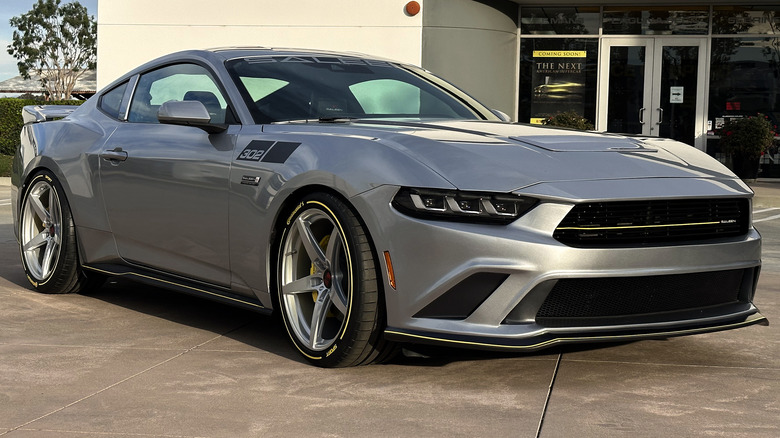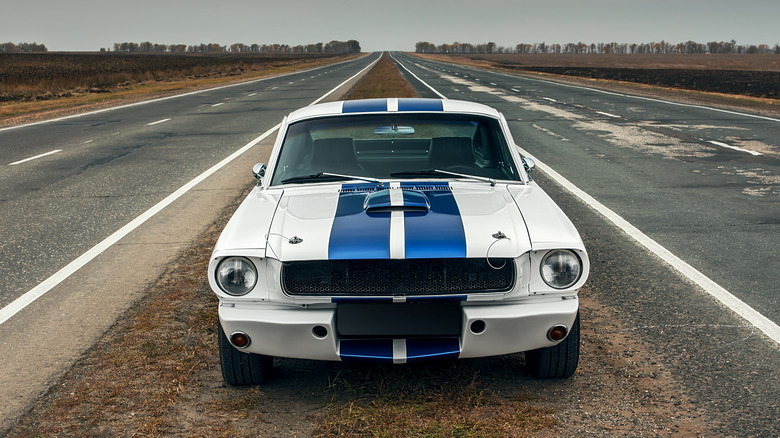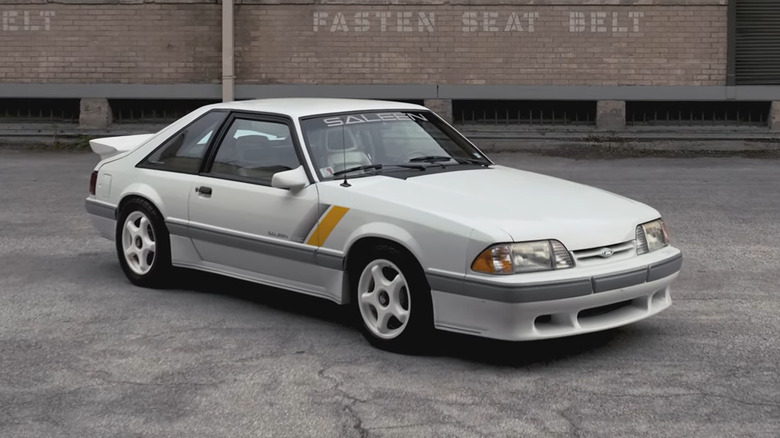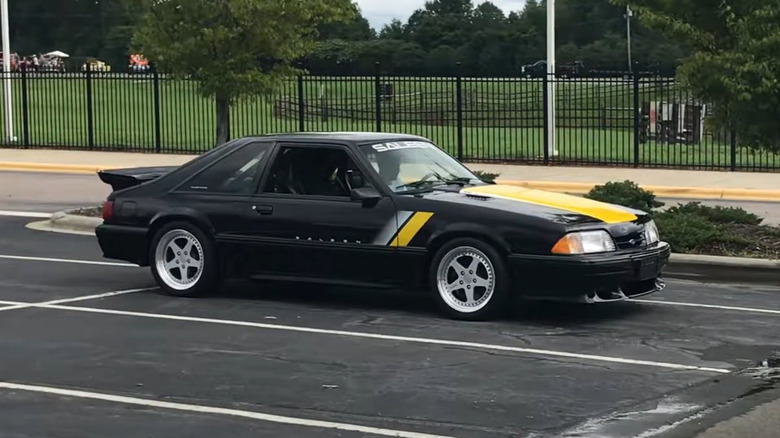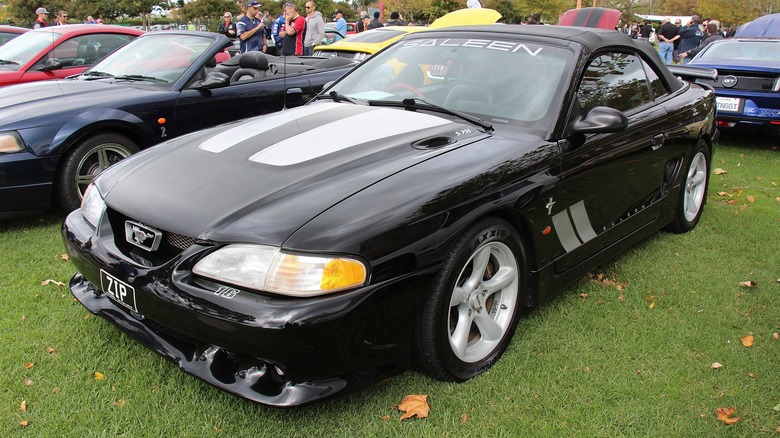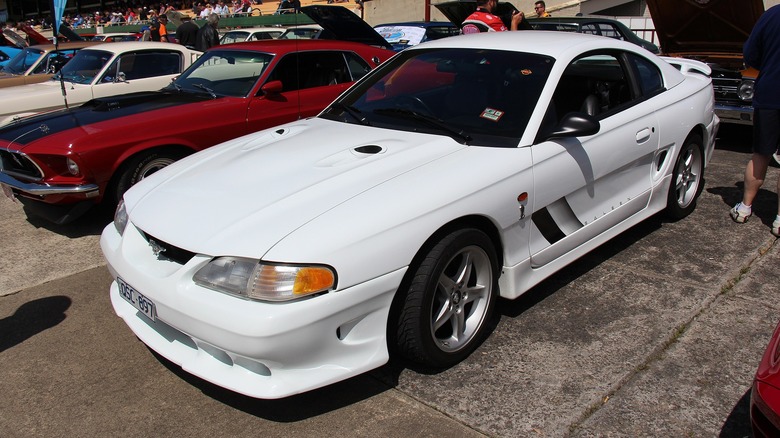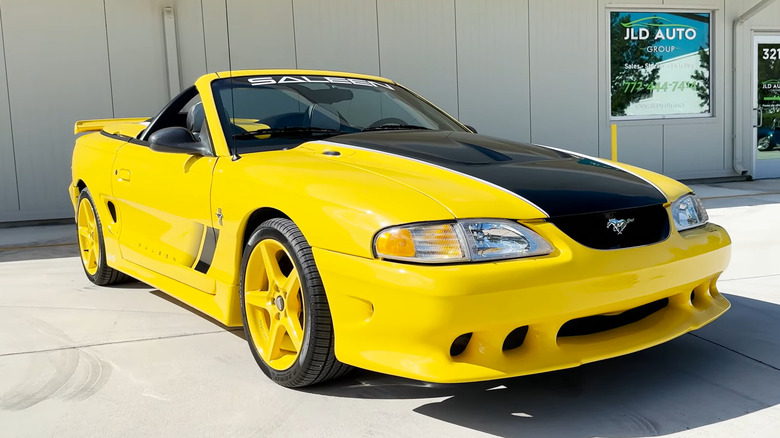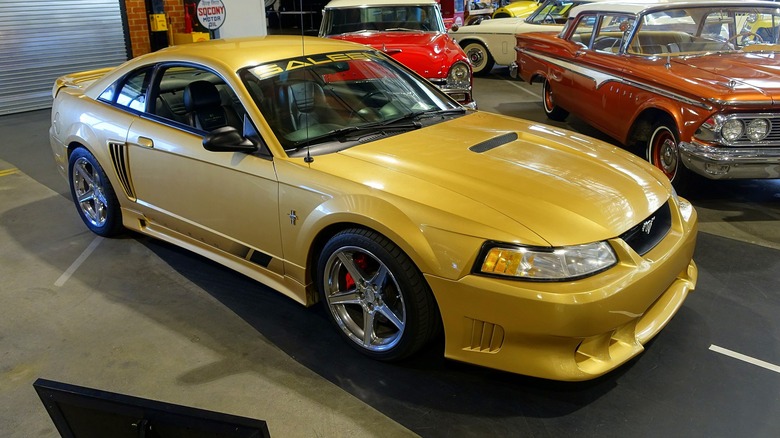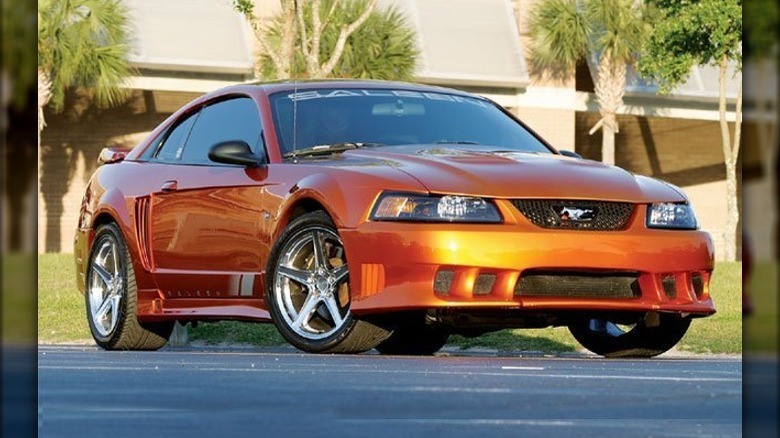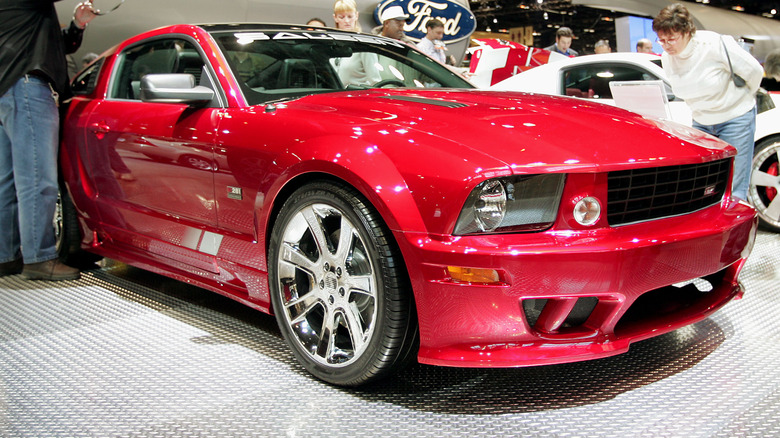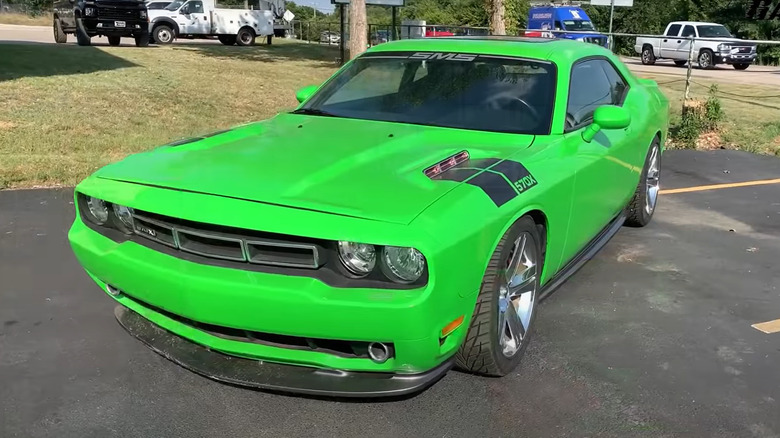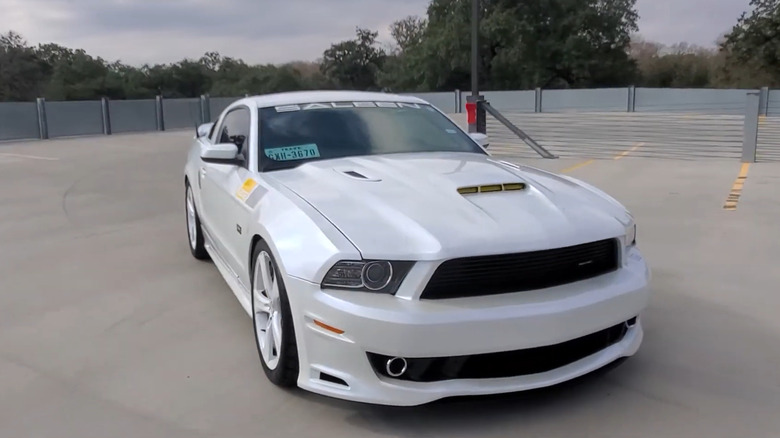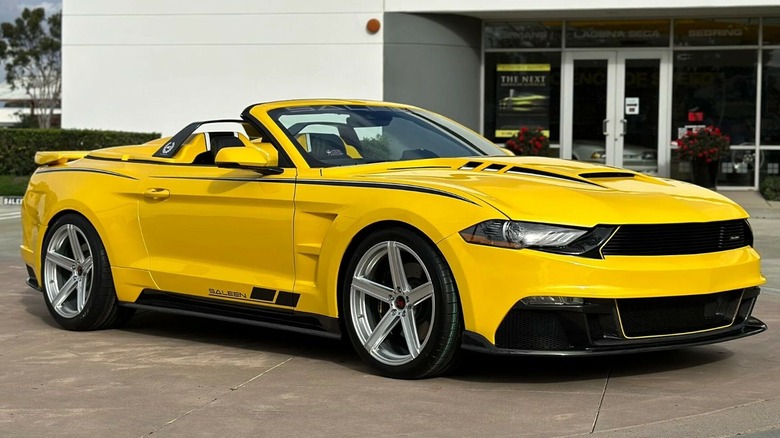Everything Ford Fans Should Know About Saleen Mustangs
Few other names are as closely associated with the history of the Ford Mustang as Steve Saleen. From humble beginnings in the early '80s to nationwide recognition less than two decades later, Saleen's rise to prominence was shaped both on the track and the street. The company's founder had spent years carving out a career as a racing driver long before he produced his first customer car, but his association with the Mustang dates back even before he took his first chequered flag.
The manufacturer has developed a wide range of custom-built models over the decades, from sporty pickup trucks to the S7 supercar, one of the world's fastest cars upon its launch. However, the Saleen brand is still (mostly) closely tied to its founder's long history of transforming Mustangs from run-of-the-mill pony cars into tire-shredding street racing machines. From his early projects to the present, we've compiled a timeline of all the key Saleen Mustangs that Ford fans should know about.
Early career and formation of Saleen Autosports
Despite Steve Saleen's close association with the Ford Mustang, his first car didn't wear a Blue Oval badge at all. His first purchase was a 1956 Porsche 356, which he customized over the following years. Saleen bought the Porsche in 1966, but by 1969, he'd swapped it out for a Shelby GT350 Mustang. He added racing suspension to the car, alongside a roll cage and twin carbs for a power boost. Unfortunately, Saleen's original Shelby was destroyed in an accident just two years later which left him with serious injuries.
Undeterred, Saleen entered his first race event in 1973 behind the wheel of a new Mustang. He won that race and spent the following decade racing professionally, mostly in open-wheel cars. By the early '80s, his focus had returned to modifying Mustangs, and so in 1983, Saleen founded his eponymous outfit from his home in California.
The fledgling tuning company focused on road and track cars, entering the SCCA Escort Endurance Championship in 1986 with a race-spec Mustang. The same year, Saleen won the 24 Hours of Mosport, the first time a Ford vehicle had won the event. The team would continue racing in the SCCA championship over the following years, racking up more wins and establishing Saleen as more than a simple tuning outfit.
Introduction of the SSC
The launch of the Saleen Mustang SSC in 1989 was instrumental in gaining wider recognition for the Saleen brand. Its introduction marked the 25th year of Mustang production and, fittingly, it was billed as the most powerful Mustang to date. Its 5.0-liter V8 was upgraded with revised heads, a new exhaust, and various other performance components, bringing its power output to around 300 horsepower.
Originally, Saleen planned to make 250 examples of the car, but only 161 were reportedly produced. In addition to its performance upgrades, the SSC is a prime example of the exterior styling that made the company's products so distinctive. A body kit and rear wing ensured that no one could mistake the SSC for a run-of-the-mill Mustang, and it was also the first car to feature Saleen's signature chevron decals. Its significance to the Saleen brand has meant that it has remained a sought-after collector's car today.
SA-10: Celebrating 10 years of production
The next notable special edition to emerge from Saleen was the 1993 SA-10, which was not built to commemorate a Ford milestone but rather one of Saleen itself. It marked 10 years of production for the brand, and so was limited to just 10 units. Unlike previous Saleen Mustangs, the SA-10 featured sequential VINs, ranging from 001 through 011. Company tradition dictated that VIN 006 was skipped; a mistake by Saleen's secretary in 1985 saw car 006 for that year left out of company filings, and ever since, Saleen never made another car sporting that number.
Only nine out of the original 10 planned units were ever completed, and only eight are known to still exist. One example was reportedly stolen just after it was delivered, and it hasn't been seen since. Whether it was eventually scrapped or stashed away somewhere remains unknown, but if it does exist, it's worth a lot of money. The SA-10 is one of the rarest Saleen special editions of all. Although none of the remaining examples have recently appeared for public sale, they've reportedly been sold in private deals for prices far above the average Saleen Mustang.
Special editions and Tim Allen collaboration
The introduction of the fourth generation Mustang in 1994 saw a new lineup of Saleen models launched, the most powerful of which was the Saleen SR. This special edition model boasted 480 horsepower, making it one of the most powerful Saleen Mustangs ever made at its launch. However, a one-off collaboration between the company and comedian Tim Allen produced even more horsepower.
Allen and Saleen worked collaboratively to customize almost every element of the car, with its engine fettled to make 500 horsepower. A full roll cage was also installed and a handmade leather interior added a luxurious touch to the build. Allen and Saleen's meeting came about by chance (the former spotted the latter in the audience at one of his shows) but the partnership turned out to be an important one. In 1995, the two men launched the "RRR" Speedlab race team, who took the manufacturers' title at the SCCA World Challenge in just their second year of competition.
The drop-top Speedster
Although Saleen is most associated with coupe and hatchback Mustangs, the company has also built a few convertible Mustangs over the years. These convertibles weren't marketed under a separate name until the launch of the Saleen 351 Speedster in 1995. The Speedster shared Saleen's suite of upgrades with the existing models in the lineup, including the Racecraft suspension and 200 mph speedometer. The car's 351 cubic inch V8 made 371 horsepower in standard form, but a supercharger could be optioned upon request to match the SR's 480 horsepower output.
Saleen claimed the top-spec Speedster was "the most powerful U.S. produced automobile" at the time of its launch, with an official 0-60 mph time of 4.7 seconds and a 12.9-second quarter mile. However, its starting price of $48,500 ensured it remained a rarity on the roads, with only 97 convertible 351 Mustangs reportedly built between 1994 and 1998.
[Featured image by Sicnag via Wikimedia Commons | Cropped and scaled | CC BY 2.0]
Entering the mainstream with the S281
The Saleen brand was catapulted even further into mainstream consciousness with the launch of the S281 in 1996. The S281 offered a less powerful but notably cheaper alternative to the S352 and SR models, with its Modular V8 engine remaining stock. The focus for the S281 was instead on handling: Saleen fitted a new exhaust, revised suspension, and of course, a revised version of its distinctive body kit.
The S281 is best remembered by many as one of the top prizes in the nationwide McDonald's Deluxe Monopoly, which offered six examples of the S281 Speedster alongside the grand prize of $1 million in cash. The promotion saw images of the Saleen Mustang grace advertisements across the U.S. and Canada, helping to raise the brand's profile among non-enthusiasts as well as those already in the know. The S281 would become the best-selling Saleen Mustang variant, with 363 Coupes and 511 convertible Speedster examples sold between 1996 and 1998.
[Featured image by Sicnag via Wikimedia Commons | Cropped and scaled | CC BY 2.0]
SA-15: Fifteen years of fast Mustangs
While the Saleen brand was gaining huge exposure thanks to the McDonald's promotion, its founder was gaining recognition from the industry for his contribution to Mustang development. Steve Saleen was inducted into the Mustang Hall of Fame in 1996, joining legends including Carroll Shelby. Saleen's "RRR" Speedlab race team, formed in partnership with Tim Allen, was also still going strong. The outfit entered the 24 Hours of Le Mans in 1997, and secured the manufacturers' title at the SCCA World Challenge the following year.
To celebrate its achievements and commemorate its 15th anniversary as a brand, Saleen launched a limited edition SA-15 model in 1998. Production was capped at just 15 units, with each example priced at $42,500. The SA-15 was based on the S281 Speedster, but featured a Roots-type supercharger to boost its power output to 320 horsepower. In addition, the car featured a unique interior with carbon fiber accents, a unique paint scheme, and racing-inspired wheels.
A lineup overhaul for '99
Ford's facelift of the Mustang for the 1999 model year saw Saleen refresh its lineup accordingly, tweaking each model's styling and power output. The two-tier offering of either a 281 or 351 V8 engine was carried over, but the latter now made 495 horsepower, a 15 horsepower boost over the previously range-topping SR. The 351 Saleen Mustang's claimed 0-60 mph time was reduced to 4.6 seconds, and it could reportedly reach 122 mph after a quarter mile.
The 285 horsepower S281 didn't boast quite such impressive acceleration figures, but it did boast a lower price than before. Saleen dropped its starting MSRP by $400, as well as reworking the car's body kit for better aerodynamics. Those looking for an extra power boost could opt for the Supercharged S281, which offered a middle ground between the entry-level S281 and the powerful but pricey S351. This new model in the lineup was good for 360 horsepower and also featured revisions to the Racecraft suspension system to help keep those extra ponies in line.
[Featured image by Daderot via Wikimedia Commons | Cropped and scaled | CC0 1.0]
Pushing Saleen to the extreme
The year 2000 saw the launch of Saleen's most ambitious project to date, the S7 supercar. Alongside the launch, the brand's racing arm also entered the newly established Grand American Road Racing Championship, achieving several race wins and eventually clinching the overall title with a Mustang. The next milestone in the roadgoing Saleen Mustang's history would arrive in 2002, with the launch of the S281 E. The E in the name stood for "Extreme," and the new model replaced the outgoing S351 in the lineup. The SR continued to serve as the line's range-topping model.
The S281 E featured a new screw-type supercharger and a new intercooler to increase the car's power output to 425 horsepower. The car's officially quoted 0-60 mph time stood at 4.6 seconds, matching that of the outgoing S351 Mustang despite being slightly down on power compared to its predecessor. Its top speed was estimated to be somewhere north of 180 mph.
Saleen's fifth-generation Mustangs and the departure of Steve Saleen
After the successful launch of the S7, Saleen was given one of its most important contracts yet from Ford. As a registered Specialty Vehicle Manufacturer, Saleen was tasked by the Blue Oval with assembling its upcoming supercar, the GT. Preparations for the assembly process began in 2003, and the same year, Saleen released the special edition SA-20 Mustang to commemorate 20 years in business.
The launch of the fifth-generation Mustang for the 2005 model year also meant a new lineup of Saleen Mustang models, including one particularly special collaboration. Saleen partnered with legendary racing driver Parnelli Jones for a limited-run Mustang inspired by Jones' 1970 Boss 302. Its naturally aspirated V8 cranked out 400 horsepower and the only paint finish available was bright orange, in tribute to Jones' classic pony car.
However, despite the brand's continued success, divisions were forming at Saleen headquarters. The company had been bought out by an investment firm in 2003, and the new leadership eventually clashed with founder Steve Saleen's ambitions. A Chinese automaker reportedly approached the company about an import partnership, but the American outfit wasn't interested. However, Saleen was keen to get on board with the project, and eventually left the company in 2007. He was announced as the new CEO of the Chinese venture, ZX Automobile Company, a few weeks later. According to initial reports, the new venture aimed to import 30,000 cars per year into the U.S. by 2009.
Formation of SMS and new Mustangs
Shortly after confirming his new role at ZX Automobiles, Steve Saleen also announced the formation of a second venture, SMS. He surrendered the rights to the Saleen name when he left his original company, so his new outfit instead used his initials, "Steve Mark Saleen." In a 2008 interview with Autoblog, Saleen stated that he was keen to develop his versions of muscle cars from Dodge and Chevrolet as well as continuing to work on the Mustang. The SMS venture, he said, gave him the freedom to do that free of his original outfit's contractual obligations.
Saleen did indeed release upgraded versions of the Dodge Challenger (pictured above) and Chevy Camaro in 2009 and 2012 respectively, but neither model proved to be as popular as the Saleen Mustang. SMS brought back the 302 Mustang in 2010, and would continue production of all three cars until the collapse of the original Saleen company allowed Steve Saleen to return to the brand.
Steve Saleen returns
Steve Saleen bought back the company that bore his name in 2012, bringing production of his SMS cars and Saleen-branded Fords back under one roof. The same year, the company resurrected the 351 Mustang name as a range-topping model with 700 horsepower. Business continued as usual in 2013, with Saleen unveiling two new limited edition Mustangs. The first was a collaboration with driver George Follmer, and paid tribute to his 1969 Mustang Boss 302.
The second was unveiled to commemorate Saleen's 30th anniversary, and following the tradition of previous anniversary cars, was christened the SA-30. Only 10 examples of the SA-30 Mustang were produced – there were also 10 Saleen Challengers and 10 Camaros built, totaling 30 special edition cars. Continuing its expansion into new segments, Saleen also unveiled the prototype of its Foursixteen Tesla Model S in 2014. It was the first time that Saleen had developed an EV, and marked a further shift away from the brand's traditional focus on the Mustang.
Modern Mustangs and Saleen's other projects
In recent years, Saleen has continued to diversify its lineup, unveiling its S1 supercar in 2017 as well as relaunching its flagship S7 in a limited run. The brand continues to produce its renowned Mustang as well, unveiling a new S302 model alongside the launch of the sixth generation Mustang in 2015. In 2023, an SA-40 special edition of the car was unveiled, with production limited to a maximum of 10 units.
Several concerns have been raised over the state of Saleen's finances since the company's resurrection, but it appears that these concerns haven't impacted the continued development of the Mustang line. At the time of this writing, the automaker is taking orders for its new 2024 Mustang 302 based on the seventh-generation pony car, with four variants available. The entry-level White Label 302 starts from $61,900, while the range-topping Black Label Supercharged costs $104,900 and boasts 800 horsepower, making it the most powerful production Saleen Mustang offered to date.
